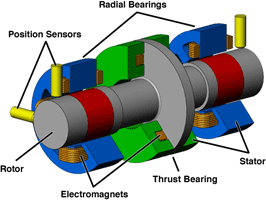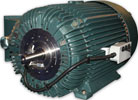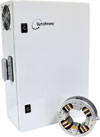
In this age of environmental consciousness, OEMs around the world are competing to build better, safer, and greener machines. Many industries are rediscovering a fundamental principle – magnetics. Magnetic bearings improve reliability, reduce friction, minimise vibration, and offer advanced health monitoring and diagnostics – all without the disadvantages of lubricants. New advances in magnetic bearings, including miniaturisation, simplicity, and integration, have accelerated their use in rotating machinery in industrial, aerospace, and defense sectors.

How a magnetic bearing operates
In the basic layout of a five-axis magnetic bearing system, two radial magnetic bearings support and position the shaft in the lateral (radial) directions, and one supports and positions the shaft along the longitudinal (axial) direction. The magnetic bearing offers little frictional resistance to rotation. Each magnetic bearing consists of a rotor that rotates with the shaft and a stator that contains electromagnets and position sensors.
An active magnetic bearing maintains clearance between the rotor and stator using a closed-loop feedback system that controls the shaft’s position. Sensors detect the local displacements, a digital processor interprets these signals, and power amplifiers provide currents to the electromagnets. The cycle of position sensing, processing, and amplification repeats 15 000 times per second. Like other bearings, a magnetic bearing provides stiffness and damping. However, unlike other bearings, the performance may be optimised by simply changing control parameters. Advanced control algorithms minimise machine vibration even under high levels of unbalance.
Reducing the magnetic bearing size
In magnetic bearings, the bearing pressure is less than in oil lubricated bearings. Therefore, for the same load capacity, magnetic bearings are larger. Historically, this has made the integration of magnetic bearings into rotating machines difficult, limiting the range of applications. Through recent design innovations, the size of radial magnetic bearings has been reduced by more than 30%. Increasing the amount of steel at the bore of the stator, while reducing the amount of steel elsewhere, has improved the bearing pressure for radial bearings. The length of the radial magnetic bearing has also been reduced by developing position sensors that can be integrated into the electromagnets.
Reducing the controller size
The controller consists of sensor conditioning electronics, analogue-to digital (A/D) converters, digital processors, digital-to-analog (D/A) converters, power amplifiers, and a communications interface.
Design innovations have systematically miniaturised or eliminated each of these components. For instance, high-speed A/D converters are eliminated by using frequency modulated (FM) position signals that are directly converted to digital values. An integrated processor architecture combines processing, power amp switching, and communications, while eliminating D/A converters. Finally, new control algorithms make it possible to reduce the size of the power amplifiers. These innovations have dramatically reduced the controller size, once as bulky as a household refrigerator, to little more than the size of a DVD player. Smaller controllers can more easily be mounted on the rotating machine, thereby eliminating the need for a separate enclosure. In fact, it is now possible to buy magnetic bearings with the controller completely integrated into the bearing itself, which eliminates the need for a separate controller.
Reducing complexity
In the past, engineers encountering a magnetic bearing system had to deal with a wide and complex array of cables and connectors. Electromagnets require dozens of wires carrying high currents and high switching frequencies. Sensors also require more than a dozen wires carrying high frequency signals. These wires were routed up to 100 metres to remote control rooms where the magnetic bearing controller was located. Long cables caused the emission of electromagnetic interference (EMI) and electrical noise pickup from the sensor wires. The new, compact controllers significantly simplify the system. A compact controller integrates into the casing of the machine by external mounting or integration into the bearing. Remote power (typically 48-300 V DC) is supplied to the controller. Short magnetic bearing cables between the controller and the machine simplify connections, reduce EMI, and eliminate special sensor tuning.
Improving health monitoring
In the past, health monitoring of a rotating machine required a dedicated vibration monitoring system. These large, expensive systems consist of proximity probes, conditioning electronics, high speed data acquisition systems, digital processors, and much hardware.
However a machine already equipped with a magnetic bearing system can also perform health monitoring without additional hardware investment. Inherent in the magnetic bearings are high resolution position sensors, digital processing, and communications. When networked to an external computer, visualisation of orbits, advanced diagnostics, trending, archiving, and alarming are all possible. Health monitoring is achieved by simply extending the functionality with additional computer software. Historically, the relatively high cost of magnetic bearings has limited the technology’s application. However, through standardisation, integration, and manufacturing advances, the cost of magnetic bearings has declined. Also, the engineering effort to integrate the magnetic bearings into a machine is greatly reduced. The net result is that magnetic bearings have become much more economical to use in new and existing rotating machinery.
Examples of advanced magnetic bearing systems
The reductions in size, complexity and cost of magnetic bearings make new applications possible.
One example is in high speed drive trains. The drive train incorporates a high efficiency permanent magnet (PM) motor/generator. A stub shaft, extending from one end of the drive train, can be used for mounting a pump, compressor or turbine wheel. The machine may be used either as an electrical motor or a generator. Because of the small size of the magnetic bearing controller, it integrates into the housing of the drive train so that the only required connections to the controller are DC power and an Ethernet network cable. A separate feedthrough for the power leads to the motor/generator is provided. The magnetic bearing controller can also control other aspects of the machine, such as the position of inlet guide vanes. The built in intelligence of the drive train often eliminates the need for an external controller.
Radial and thrust bearings with completely integrated control electronics are another example. A typical rated load capacity for the radial bearing is 140 kg, with a rating for the thrust bearing being 450 kg. Despite the integration of the control electronics, the size of these bearings is less than past magnetic bearings that required an additional, large external controller. Each bearing is powered by 48 V DC and includes a dedicated Ethernet port for high speed communications and health monitoring. The small size and simplified mechanical and electrical interface make it easy to integrate the bearing into rotating machines such as motors, pumps, fans, and turbines.

A compact magnetic bearing controller can be located close to or directly on a rotating machine. The controller includes all signal conditioning, digital processing, power amplification, and high-speed network communications. Despite its small size, each power amplifier is rated at 7500 VA. Machine mounting the controller eliminates long cable runs for the coil and sensor wires, simplifies connectors, reduces EMI, and eliminates special sensor tuning. The controller box may be purged if located in an explosive environment. The external connections to the controller include DC power cables and an Ethernet network cable. Also included in the compact controller are spare I/O and spare processing power, which facilitate the industrial trend toward locally controlled, intelligent machinery.

Conclusion
Through technical advances, magnetic bearings now offer advantages for a much broader range of machines and applications. Design innovations related to miniaturisation, integration, and standardisation continue to increase the general acceptance of magnetic bearings for many new and existing applications, setting the standard for better, smaller, and greener.
For more information visit http://www.synchrony.com

© Technews Publishing (Pty) Ltd | All Rights Reserved